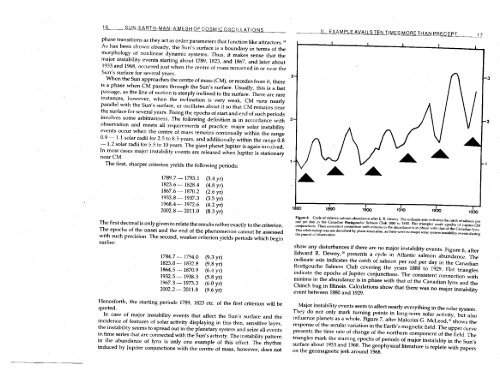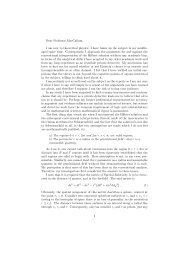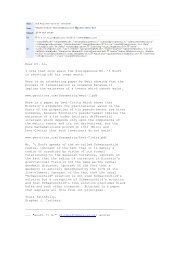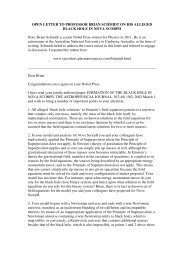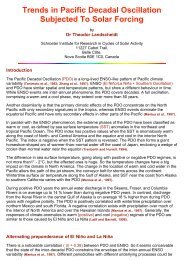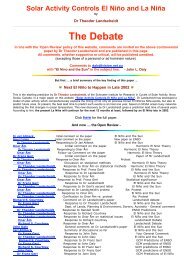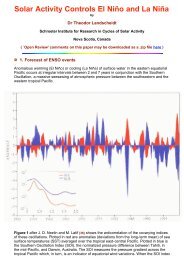Sun-Earth-Man - PlasmaResources
Sun-Earth-Man - PlasmaResources
Sun-Earth-Man - PlasmaResources
Create successful ePaper yourself
Turn your PDF publications into a flip-book with our unique Google optimized e-Paper software.
1<br />
7 6 - I I . EXAMPLE AVAILSTENTIMESMORETHAN PRECEPT 7 Z<br />
phase transitions as they act as order parameters that function like attractors.<br />
As has been shown already, the <strong>Sun</strong>'s surface is a boundary in terms of the<br />
morphology of nonlinear dynamic systems. Thus, it makes sense that the<br />
major instability events starting about 1789, 1823, and 1867, and later about<br />
1933 and 1968, occurred just when the centre of mass remained in or near the<br />
<strong>Sun</strong>'s surface for several years.<br />
When the <strong>Sun</strong> approaches the centre of mass (CM), or recedes from it, there<br />
is a phase when CM passes through the <strong>Sun</strong>'s surface. Usually, this is a fast<br />
passage, as the line of motion is steeply inclined to the surface. There are rare<br />
instances, however, when the inclination IS very weak, CM runs nearly<br />
parallel with the <strong>Sun</strong>'s surface, or oscillates about it so that CM remains near<br />
the surface for several years. Fixing the epochs of start and end of such periods<br />
involves some arbitrariness. The following definition is in accordance with<br />
observation and meets all requirements of practice: major solar instability<br />
events occur when the centre of mass remains continually within the range<br />
0.9 - 1.1 solar radii for 2.5 to 8.5 years, and additionally within the range 0.8<br />
- 1.2 soIar radii for 5.5 to 10 years. The giant planet Jupiter is again involved.<br />
In most cases major instability events are released when Jupiter is stationary<br />
near CM.<br />
The first, sharper criterion yields the following periods:<br />
1789.7 - 1793.1 (3.4 yr)<br />
1823.6 - 1828.4 (4.8 yr)<br />
1867.6 - 1870.2 (2.6 yr)<br />
1933.8 - 1937.3 (3.5 yr)<br />
1968.4 - 1972.6 (4.2 yr)<br />
2002.8 - 2011.0 (8.3 yr)<br />
The first decimal is only given to relate the results rather exactly to the aiterion.<br />
The epochs of the onset and the end of the phenomenon cannot be assessed<br />
with such precision. The second, weaker criterion yields periods which begin<br />
earlier:<br />
1784.7 - 1794.0 (9.3 yr)<br />
1823.0 - 1832.8 (9.8 yr)<br />
1864.5 - 1870.9 (6.4 yr)<br />
1932.5 - 2938.3 (5.8 yr)<br />
1967.3 - 1973.3 (6.0 yr)<br />
2002.2 - 2011.8 (9.6 yr)<br />
Henceforth, the starting periods 1789, 1823 etc. of the first criterion will be<br />
quoted.<br />
In case of major instabitity events that affect the <strong>Sun</strong>'s surface and the<br />
incidence of features of solar activity displaying in this thin, sensitive layer,<br />
the instability seems to spread out in the planetary system and seize all events<br />
in time series that are connected with the <strong>Sun</strong>'s activity. The instability pattern<br />
in the abundance of lynx is only one example of this effect. The rhythm<br />
induced by Jupiter conjunctions with the centre of mass, however, does not<br />
Fig- 6: Cyde of Atlantic salmon abundance after E. R. Dewey The ordinate ads ~ndicates the catch of salmon per<br />
rod per day m the Canad~an Restigouche Salmon Club 1880 to 1910 Flat hiangtes mark epochs of Jupter-CM<br />
mnjunrhons Their consirtcnt connection wlth minima in the abundance ir in phase with that of the Canadian lynx<br />
Ths relationshtp was not dishrbed by phase anomalies, as therewere no malor solar system instability eventsduring<br />
the period oi obsewatton.<br />
show any disturbances if there are no major instability events. Figure 6, after<br />
Edward R. De~ey,~ presents a cycle in Atlantic salmon abundance. The<br />
ordinate ads indicates the catch of salmon per rod per day in the Canadian<br />
Restigouche Salmon Club covering the years 1880 to 1929. Flat triangles<br />
indicate the epochs of Jupiter conjunctions. The consistent connection with<br />
minima in the abundance is in phase with that of the Canadian lynx and the<br />
Chinch bug in Illinois. Calculations show that there was no major instability<br />
event between 1880 and 1929.<br />
Major instability events seem to affect nearly everything in the solar system.<br />
They do not only mark turning points in long-term solar activity, but also<br />
influence planets as a whole. Figure 7, after Malcolm G. McLeod," shows the<br />
response of the secular variation in the <strong>Earth</strong>'s magnetic field. The upper curve<br />
presents the time rate of change of the northern component of the field. The<br />
triangles mark the starting epochs of periods of major instability in the <strong>Sun</strong>'s<br />
surface about 1933 and 1968. The geophysical literature is replete with papers<br />
on the geomagnetic jerk around 1968.


